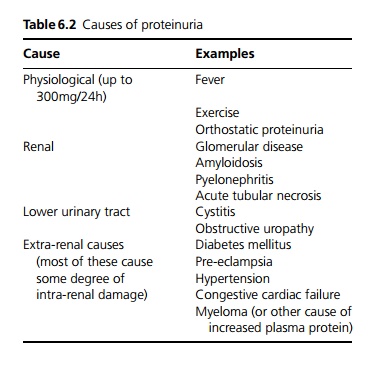Chapter: Medicine and surgery: Genitourinary system
Proteinuria - Investigations and procedures
Proteinuria
Definition
A greater than normal amount of protein in the urine.
Aetiology
Causes of proteinuria include those shown in Table 6.2.

Pathophysiology
The glomeruli normally filter 7–10 g of protein per 24 hours, but less than 2% of this is actually excreted because protein is actively reabsorbed in the proximal tubules. Normal urinary protein excretion is <150 mg/24 h, of which less than 35 mg is albumin. Proteinuria may occur by various mechanisms.
1. Overflow: Increased plasma protein exceeding tubular resorptive capacity, such as occurs in multiple myeloma.
2. Glomerular proteinuria is due to increased permeability of the glomerular basement membrane. Glomerular proteinuria may range from mild to heavy. Heavy proteinuria (>3 g/day) is termed nephrotic range proteinuria which indicates glomerular pathology. Nephrotic range proteinuria with hypoalbuminaemia and oedema is termed nephrotic syndrome.
3. Tubular disease causes impaired reabsorption of protein. Urinary β2-microglobulin can be used as a measure of tubular function, because this small peptide is completely filtered by the glomeruli and completely reabsorbed by normal tubules. The proteinuria is usually mild in tubular disease, such as in acute tubular necrosis or pyelonephritis.
4. Increased secretion of protein (Tamm–Horsfall protein) by the kidneys or uroepithelium, which normally accounts for half of the total protein excretion, occurs in orthostatic proteinuria, fever and exercise.
Clinical features
Proteinuria is usually asymptomatic, although heavy proteinuria may be noticed as frothy urine, or if nephrotic syndrome develops. Protein excretion increases in the upright position, and proteinuria, which disappears on early morning collection before ambulation is called orthostatic proteinuria, a benign condition affecting 2–5% of adolescents, but uncommon over the age of 30 years. If significant proteinuria is found, a careful history and examination should be made to look for an underlying cause, together with appropriate investigations.
Investigations
All positive urine dipstick measurement of protein should be confirmed by laboratory testing. Dipstick detects albumin most sensitively, but false positives are caused by alkaline urine, antibiotics and X-ray contrast media. False negatives occur when there is proteinuria without much albuminuria, e.g. Bence Jones protein.
24-hour urinary protein should be quantified with a formal 24-hour urine collection, although this is being superseded by spot urinary protein:creatinine ratios (≤0.1 g = normal; 0.1–0.2 g = trace, 0.2–1.0 g = low-grade proteinuria, 1.0–3.0 g = moderate proteinuria, ≥3.0 g = nephrotic range proteinuria).
Initial investigations include:
· Urinalysis and microscopy to look for haematuria and evidence of urinary tract infection.
· U&E’s, glucose to look for diabetes. Serum immunoglobulins and plasma protein electrophoresis.
· Renal ultrasound.
· Urine electrophoresis for Bence Jones protein or differentiating glomerular (mainly albumin) from tubular loss (lighter chain proteins).
· Renal biopsy may be necessary to make a diagnosis.
Management
Depends on underlying cause and severity. Often mild isolated proteinuria is treated expectantly after baseline investigations (BP, U&Es, plasma creatinine) have been done.
Prognosis
Microalbuminuria (30–200 mcg albumin/24 h or an early morning urine albumin:creatinine ratio >3) pre-dicts mortality and renal failure in diabetes mellitus and cardiovascular deaths in the elderly. It also occurs in hypertension, myocardial infarction and as part of the acute phase response.
Related Topics